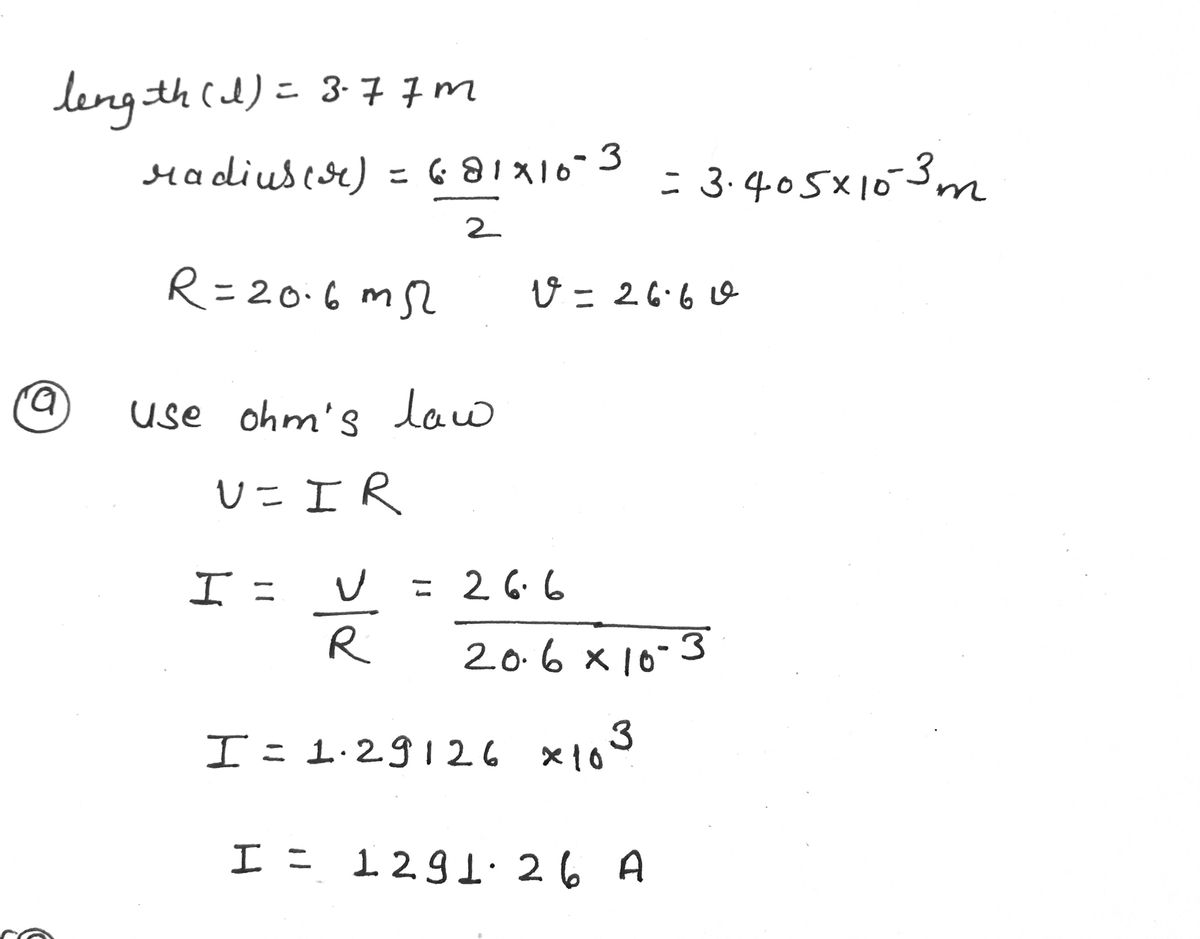Question

Transcribed Image Text:A wire 3.77 m long and 6.81 mm in diameter has a resistance of 20.6 m2. A potential difference of 26.6 V is applied between the ends.
(a) What is the current in amperes in the wire? (b) What is the magnitude of the current density? (c) Calculate the resistivity of the
material of which the wire is made.
(a) Number 1
(b) Number i
(c) Number i
Units
Units
Units
>
>
Expert Solution
arrow_forward
Step 1

Step by stepSolved in 2 steps with 2 images

Knowledge Booster
Similar questions
- There is a potential difference of 0.90 V between the ends of a 20 cm long graphite rod that has a cross-sectional area of 1.8 mm2. The resistivity of graphite is 7.5 x 10-6 2-m. (a) Find the resistance of the rod. (b) Find the current. (c) Find the electric field inside the rod.arrow_forwardare made of the same metal. 7) wires 1 and 2 wire 2 has twice the length and twice the diameter of wire 1. What are the ratios (a) Q₂/Q² of the resistivities and (b) R.2/121 of the resistance of the two wires? A) P₁/P₁ = 1, 1₂/1²₁=0.5 13) P₂/p₁ = 1, 82₂/124₁ =0.25 C) P₁/P₁ = 0.5² h₂/1²₁=0.5 D) P₁/P₁ = 0.25, 1₂₁/1²₁=0.5 2 रarrow_forwardThere is a potential difference of 1.7 V between the ends of a 10 cm long graphite rod that has a cross-sectional area of 1.7 mm2. The resistivity of graphite is 7.5 10-6 Ω-m. (a) Find the resistance of the rod.\ (b) Find the current. (c) Find the electric field inside the rod.arrow_forward
- (a) A 35.5-m length of copper wire at 20.0°C has a radius of 0.23 mm. If a potential difference of 7.0 V is applied across the length of the wire, determine the current in the wire. (Use the values in the following table.) Resistivities and Temperature Coefficients of Resistivity for Various Materials (at 20°C) Material Silver A Copper Gold Aluminum Tungsten Iron Platinum Lead Nichrome a Carbon Germanium Silicon Glass Hard rubber Sulfur Quartz (fused) Resistivity (2. m) 1.59 x 107 1.7 x 10-8 2.44 x 10-8 2.82 x 10 5.6 x 107 10.0 x 10 11 x 10 -8 -8 0.46 -8 640 22 x 10-8 3.5 x 107 -8 -8 150 x 10- -8 -5 1010-1014 ≈1013 1015 75 x 1016 Temperature Coefficient of Resistivity [(°C)-¹] 3.8 x 10 -3 3.9 × 10-3 3.4 x 10-3 3.9 x 107 5.0 x 10 4.5 x 10-3 3.92 x 10 -3 -3 0.4 x 107 -3 3.9 × 10-3 -3 -3 -0.5 x 107 -48 x 10-3 -75 x 10-3 aA nickel-chromium alloy commonly used in heating elements. (b) If the wire is heated to 40.0°C while the 7.0-V potential difference is maintained, what is the resulting…arrow_forwardA 2.0 mm diameter iron wire ( resistivity, p = 9.7 x 10-° 2-m) carries a current of 2.5 A. Determine the potential difference across this 20m length of the wire. (A 1.544 v B 0.544 v C) 1.618 v 0.618 varrow_forwardA wire 3.43 m long and 6.38 mm in diameter has a resistance of 11.6 mQ. A potential difference of 17.7 V is applied between the ends. (a) What is the current in amperes in the wire? (b) What is the magnitude of the current density? (c) Calculate the resistivity of the material of which the wire is made. (a) Number Units (b) Number i Units (c) Number i Units >arrow_forward
- A gold wire of 0.500 mm diameter has 8.50 × 1028 conduction electrons per cubic meter. If the drift speed is 4.30 μm/s, what is the current in the wire?arrow_forwardThe graph below shows data for a wire that is 9 m long & has a cross-sectional area of 0.002 m². The wire is made from an unknown material. Determine the resistivity of the material and the power loss of the wire when the current is 100 A. VOLTAGE vs. CURRENT GRAPH V (V) 500 400 300 200 100 20 40 60 80 1 (A) 100 resistivity of wire = power loss (when I = 100 A) = ABACHER 2-marrow_forwardAs part of a class project you are given 0.900 g of copper and asked to fabricate a wire with uniform cross-section. You use up 95% of the copper and make a wire with a resistance of 0.723 Ω. The resistivity of copper is 1.72 10-8 Ω · m and its density is 8.92 103 kg/m3. (a) What length of wire do you end up with? (m)(b) What is the diameter of the wire? (mm)arrow_forward
arrow_back_ios
arrow_forward_ios